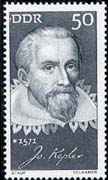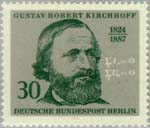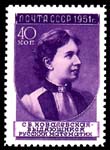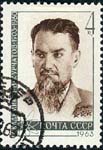|
|
K
Lebanese physicist, mathematician, scientist - Lebanon C623
Born: 11 May 1881 in Budapest, Hungary
Karman founded the U.S. Institute of Aeronautical Sciences. His contributed on fluid mechanics, turbulence theory and supersonic flight. He studied applications of mathematics to engineering, aircraft structures and soil erosion. Stamps from Central Africa 761, 1060a; United States USA1992H31. Biography
Kepler, a German mathematician, is best known for his three laws of planetary motion, derived empirically from Tycho Brahe's data and observations, which describe the solar system having the sun at the focus of elliptic planetary orbits. In his writings on conic sections he introduced the word "focus" into mathematical language. In 1609, while Galileo was making his first "astounding discoveries", Kepler published The New Astronomy and described the laws that appeared to govern the movements of the planets: They revolve around the Sun in elliptical, not circular orbits; their speed of revolution varied so that they passed through equal degrees of arc in equal periods of time; and the time that they took to complete their journey around the sun was proportional to the cube of their average distance from the sun.
Born: 26 June 1824 in Belfast, Ireland
Athanasius Kircher was born on May 2, 1602 or 1601 in Geisa, Thuringia Germany. From his birthplace he was accustomed to add the Latin epithet Bucho, or Buchonius, to his name, although later he preferred calling himself Fuldensis after Fulda, the capital of his native country. The name Athanasius was given him in honour of the saint on whose feast he was born. Athanasius Kircher was the youngest of six sons (there were also 3 daughters) of Johannes Kircher of Mainz. As soon as he had obtained the doctor's degree of Theology, he went to the Benedictine house at Seligenstadt. Afterwards, Johannes Kircher was called by the Prince-Abbot Balthasar of Fulda, who named him councillor and named him baliff (Amtman) of Haselstein, one of the "Aemter" of Fulda. The abbot was expelled due to political upheaval, and Kircher also lost his position. Thereafter he moved with his family to Geisa a.d. Ulster, where he dedicated himself to scholarship and raising his children. He declined all subsequent offers for political positions. All six sons entered religious orders because the family was too poor to educate them otherwise. In 1614-1618 Athanasius Kircher learned Greek and Hebrew at the Jesuit Gymnasium in Fulda. He entered the Jesuit order at Paderborn on 2 October, 1618. In 1618-1622 he studied humanities, natural science, and mathematics at Paderborn. After the college was closed due to military pressure, he finished his education in philosophy at Cologne. In 1623 Athanasius Kircher took up humanities and languages and taught Greek at Koblenz. In 1624 he studied languages and "physical curiosities" at Heiligenstadt. In 1625-1628 Athanasius Kircher studied theology at Mainz. While still a student, he taught to support himself. At Koblenz (1623), he taught Greek, at Heiligenstadt (1624), he taught grammar, and at Mainz, he taught Greek and conducted the choir. Magnes sive de arte magnetica opus tripartitum" by Athanasius Kircher in 1641 contains all that was known in his day on the subject of electricity and magnetism. Kircher's Magnes is filled with curiosities, both profound and frivolous. The work does not deal solely with what modern physicists call magnetism. Kircher discusses, for example, the magnetism of the earth and heavenly bodies; the tides; the attraction and repulsion in animals and plants; and the magnetic attraction of music and love. He also explains the practical applications of magnetism in medicine, hydraulics, and even in the construction of scientific instruments and toys. In the epilogue Kircher moves from the practical to the metaphysical (and Aristotelian) when he discusses the nature and position of God: the central magnet of the universe. This work contains the first use of the term "electro-magnetism", (page 640). This work, like others of Kircher's printed works, became very popular. The Magnes had a powerful influence upon Otto von Guericke, while Jungius, Leibniz and others quoted from Kircher's works. While William Gilbert's De magnete (1600), the first thoroughly modern treatment of magnetism, influenced Kircher considerably, Kircher adapts Gilbert's theories of magnetism and Kepler's work in astronomy, but does not hesitate to refute either.
Chinese astronomer, author - Chinese People's Republic 645
Russian atomic physicist, author, journalist. Born January 12, 1903, Sim, Chelyabinsk, Russia, died February 7, 1960, Moscow. - Stamp USSR 2711; 4804
Astronomer - Nicaragua Stamp NIC1994
|
|
|||||
|
|










